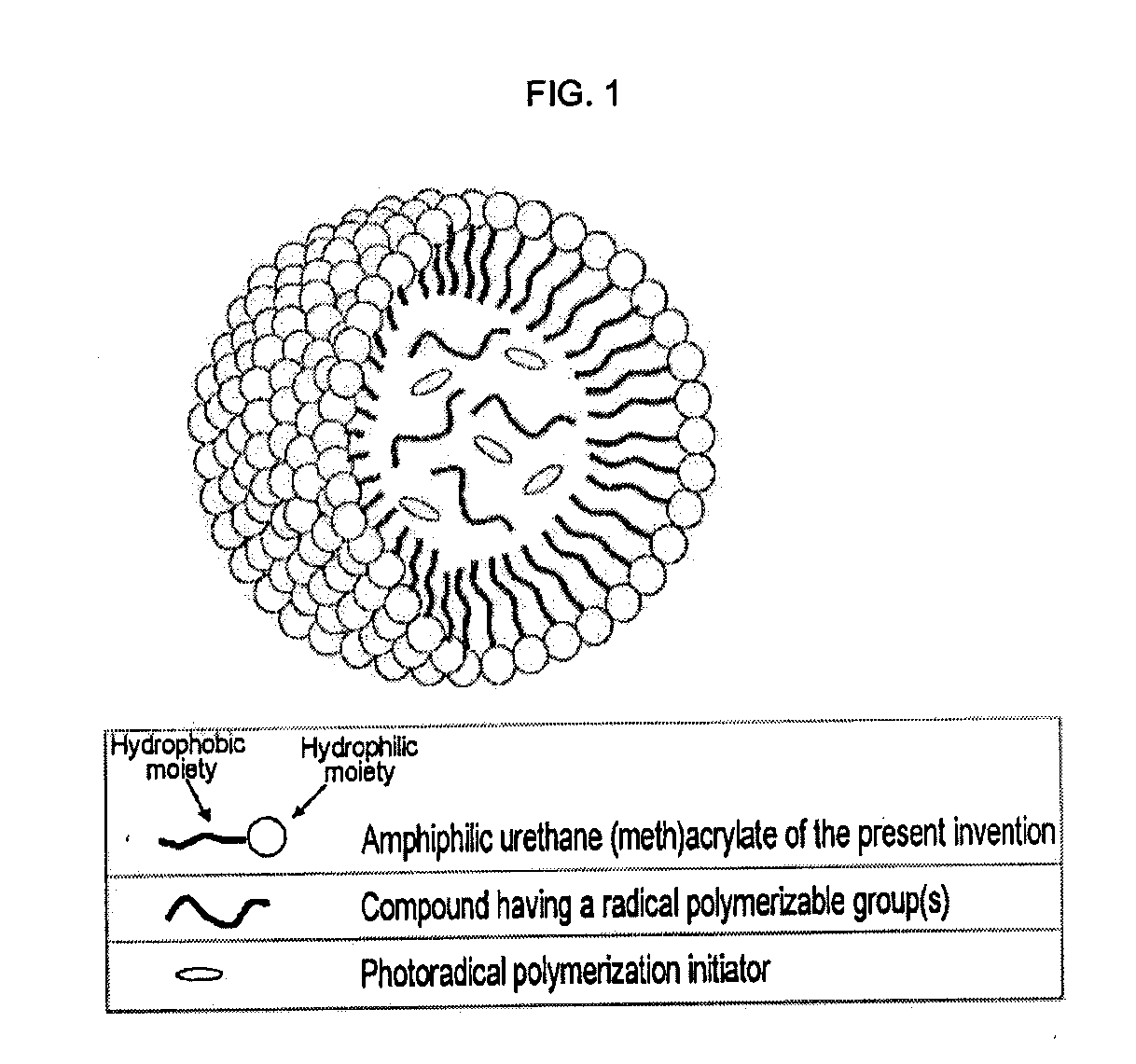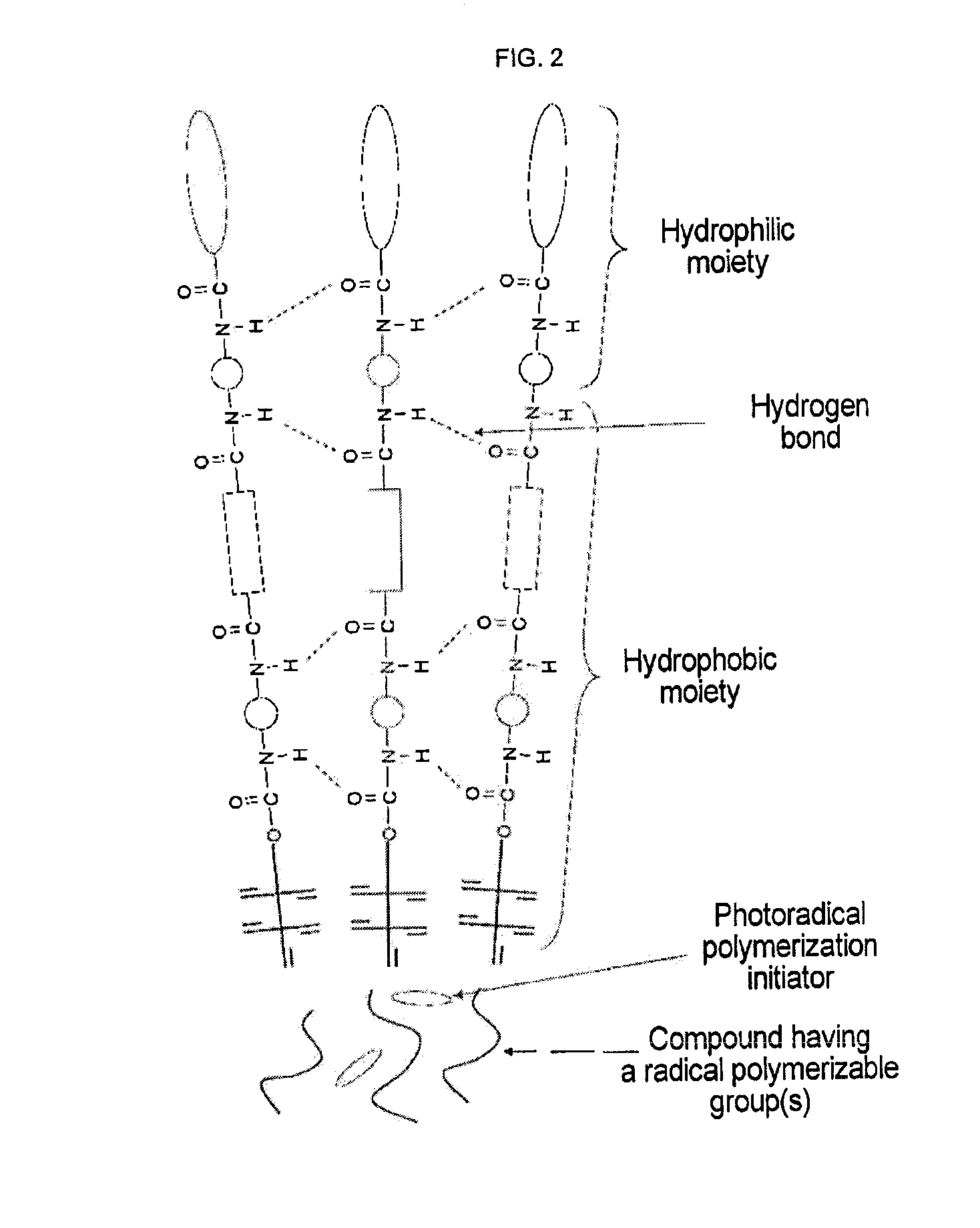Ink composition for ink jet
a technology of composition and ink jet, which is applied in the direction of inks, coatings, printing, etc., can solve the problems of inability to fix the ink printed on ink-nonabsorbing recording media, the inability to perform high-speed printing, and the respect of curability, and achieve excellent curability
- Summary
- Abstract
- Description
- Claims
- Application Information
AI Technical Summary
Benefits of technology
Problems solved by technology
Method used
Image
Examples
synthesis example 1
Synthesis of Amphiphilic Urethane Acrylate (a)
[0269]In a reaction vessel equipped with a stirrer, a condenser tube, a dropping funnel and an air introduction tube, 444.6 parts by mass of IPDI and 202.3 parts by mass of 1,12-dodecanediol were placed, and while the resulting mixture was being stirred, 0.26 part by mass of tin octylate was added to the mixture, the temperature inside the reaction vessel was increased to 90° C., and the resulting mixture was allowed to react for 1.5 hours. Then, 200.0 parts by mass of methoxy PEG 400, 200.0 parts by mass of methoxy PEG 1000 and 0.42 part by mass of tin octylate were added to the reaction mixture, and the resulting mixture was allowed to react further for 1.5 hours. Next, in the reaction vessel, 634.3 parts by mass of PPG acrylate, 0.84 part by mass of methoquinone (hydroquinone monomethyl ether) and 0.67 part by mass of tin octylate were placed and mixed, and under air bubbling, the temperature inside the reaction vessel was increased t...
synthesis example 2
Synthesis of Amphiphilic Urethane Acrylate (b)
[0270]In the same reaction vessel as in Synthesis Example 1, 444.6 parts by mass of IPDI and 202.3 parts by mass of 1,12-dodecanediol were placed, and while the resulting mixture was being stirred, 0.26 part by mass of tin octylate was added to the mixture, the temperature inside the reaction vessel was increased to 90° C., and the resulting mixture was allowed to react for 1.5 hours. Then, 200.0 parts by mass of methoxy PEG 400, 200.0 parts by mass of methoxy PEG 1000 and 0.42 part by mass of tin octylate were added to the reaction mixture, and the resulting mixture was allowed to react further for 1.5 hours. Next, in the reaction vessel, 594.4 parts by mass of pentaerythritol triacrylate, 0.82 part by mass of methoquinone and 0.66 part by mass of tin octylate were placed and mixed, and under air bubbling, the temperature inside the reaction vessel was increased to 85° C. and the resulting mixture was allowed to react for 3 hours. Then,...
synthesis example 3
Synthesis of Amphiphilic Urethane Acrylate (c)
[0271]In the same reaction vessel as in Synthesis Example 1, 444.6 parts by mass of IPDI and 202.3 parts by mass of 1,12-dodecanediol were placed, and while the resulting mixture was being stirred, 0.26 part by mass of tin octylate was added to the mixture, the temperature inside the reaction vessel was increased to 90° C., and the resulting mixture was allowed to react for 1.5 hours. Then, 200.0 parts by mass of methoxy PEG 400, 200.0 parts by mass of methoxy PEG 1000 and 0.42 part by mass of tin octylate were added to the reaction mixture, and the resulting mixture was allowed to react further for 1.5 hours. Next, in the reaction vessel, 1300.0 parts by mass of dipentaerythritol pentaacrylate, 1.17 parts by mass of methoquinone and 0.94 part by mass of tin octylate were placed and mixed, and under air bubbling, the temperature inside the reaction vessel was increased to 85° C. and the resulting mixture was allowed to react for 3 hours....
PUM
| Property | Measurement | Unit |
|---|---|---|
| Mass | aaaaa | aaaaa |
| Polarity | aaaaa | aaaaa |
| Solubility (mass) | aaaaa | aaaaa |
Abstract
Description
Claims
Application Information
 Login to View More
Login to View More - R&D
- Intellectual Property
- Life Sciences
- Materials
- Tech Scout
- Unparalleled Data Quality
- Higher Quality Content
- 60% Fewer Hallucinations
Browse by: Latest US Patents, China's latest patents, Technical Efficacy Thesaurus, Application Domain, Technology Topic, Popular Technical Reports.
© 2025 PatSnap. All rights reserved.Legal|Privacy policy|Modern Slavery Act Transparency Statement|Sitemap|About US| Contact US: help@patsnap.com



